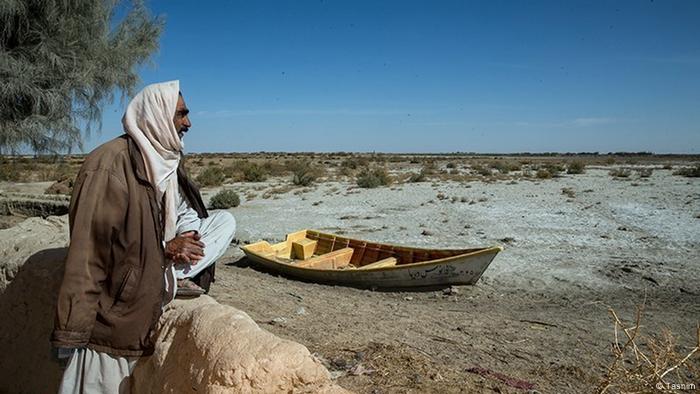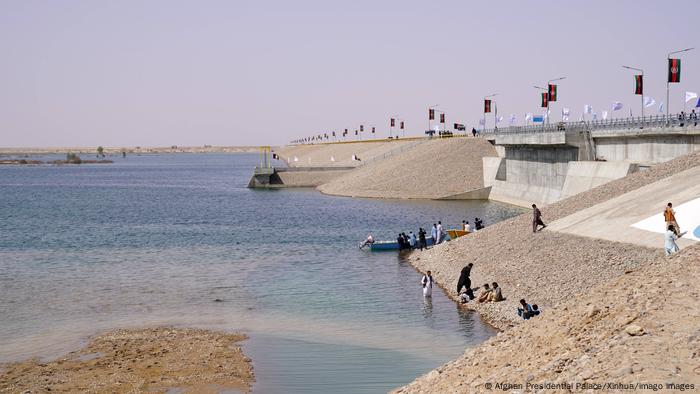Both Afghanistan and Iran need the water from the border river Helmand. cooperation would be necessary. Instead, deadly shots were fired recently.

The dried up Lake Hamun at the Iran-Afghan border
Taliban fighters from Afghanistan shot dead two Iranian border guards and the commander of the Sasuli border guard post on May 27. According to the Taliban, one person has died in Afghanistan. Both sides now accuse each other of opening fire. The exchange of fire took place in front of an explosive background. An old dispute between Iran and Afghanistan has flared up again: the conflict over the Helmand River, one of the most important water sources on the shared border.
The Helmand (other spelling Hilmend, editor's note), which has its source in the mountainous region near the capital Kabul, is the longest river in Afghanistan and flows into Lake Hamun on the border with Iran, on whose territory the larger one is located part of the lake is located. Lake Hamun, which has no outflow, is the largest freshwater lake in Iran and is of great importance for the region's environment and economy. Iran and Afghanistan share a border that is around 950 kilometers long. The situation has been tense since the Taliban took power in the summer of 2021. Incidents keep happening.
“Six months before the Taliban took power, Tehran received a Taliban delegation, among other things, to reach agreements on water rights. The Taliban now seem unwilling to honor these agreements,” explains Najib Agha Fahim, an environmental expert from Afghanistan. As a former Minister for Combating Natural Disasters under President Ashraf Ghani, he emphasizes the need for a sustainable solution: “To achieve this, technical commissions of both countries must work more closely together and exchange information to determine how much water there is and how much is going to Iran flowed.”
For years, Iran has accused Afghanistan of holding back Helmand River water in violation of a 1973 treaty. Afghanistan denies that. It's raining less, they say. The river therefore carries less water. However, Afghanistan has dammed the Helmand right on the border with Iran. The Kamal Khan Dam was opened in March 2021 after a long construction period. Tehran claims the dam will significantly reduce the river's discharge.

In January 2021, Iranian Foreign Minister Mohammad Javad Zarif received a Taliban delegation in Tehran
Immediately after the Taliban took power in August 2021, some local Iranian media reported that more water had flowed into Iran again. The Taliban allegedly opened additional drains at the Kamal Khan Dam. There was no official confirmation from Tehran or Kabul.
Long before they came to power, Tehran actually had good relations with the Taliban. The main common ground was the rejection of the USA and its presence in the region. Iran has not officially recognized the Taliban government. However, Tehran is trying to take a pragmatic approach to those in power in Kabul. Because the preservation of Lake Hamun also requires close cooperation. But that doesn't seem to work. “Last year, Iran is said to have received only four percent of the contracted amount of water,” Hassan Kazemi Qomi, Iran's special envoy for Afghanistan, said in an interview last week with the state-run Tasnim news agency, which is close to the Revolutionary Guards. Qomi has traveled to Kabul to settle the matter.
“Both Tehran and the Taliban show no interest in tackling the environmental problems in the region or counteracting the chronic mismanagement of water resources,” Iranian environmental expert Nik Kowsar told DW. Kowsar currently resides in Washington, D.C. and researches the consequences of climate change in the greater region of Syria, Iraq, Iran and Afghanistan. “Both sides are looking for short-term solutions and want to solve their own internal problems. The Taliban want to promote agriculture. And the government in Tehran is acting as if it is suddenly interested in the disadvantaged provinces of Sistan and Balochistan after the nationwide protests.” Most of Lake Hamun, into which the Helmand flows, lies precisely in this province.

Kamal Khan dam in Afghanistan
The border region with Afghanistan is a stronghold of the resistance in Iran
The region on the Afghan border is one of the poorest in Iran. Due to persistent drought and poor water management in agriculture, water is very scarce. The province is systematically disadvantaged. Small towns and villages have no schools, no electricity and no water supply. In the course of the nationwide protests after the death of Jina Mahsa Amini in police custody, the provincial capital Zahedan has become a stronghold of the protests. Despite brutal repression, demonstrators continue to gather on the streets and protest against the political system. In response, the central government is increasingly resorting to violence.
The military has now increased its presence on the ground. On Sunday, May 28, the Commander of the Ground Forces of the Iranian Army and the Deputy of the Iranian Police had traveled to Sistan and Balochistan. On site, they informed the press that everything was under control. Tehran and Kabul have agreed on a commission of inquiry to find out what happened at the border shooting.
In Iran, many people are angry. Three soldiers lost their lives. “Some wish for a war against the Taliban,” said Brigadier General Amir Ali Hajizadeh, commander of the Revolutionary Guards Aerospace Forces, on Monday, May 29, at an event at the University of Science & Technology (Elm-O-Sanat) in Tehran. “But our enemies are behind these provocations. They want to start a war out of these clashes on the border. It will definitely not happen.”